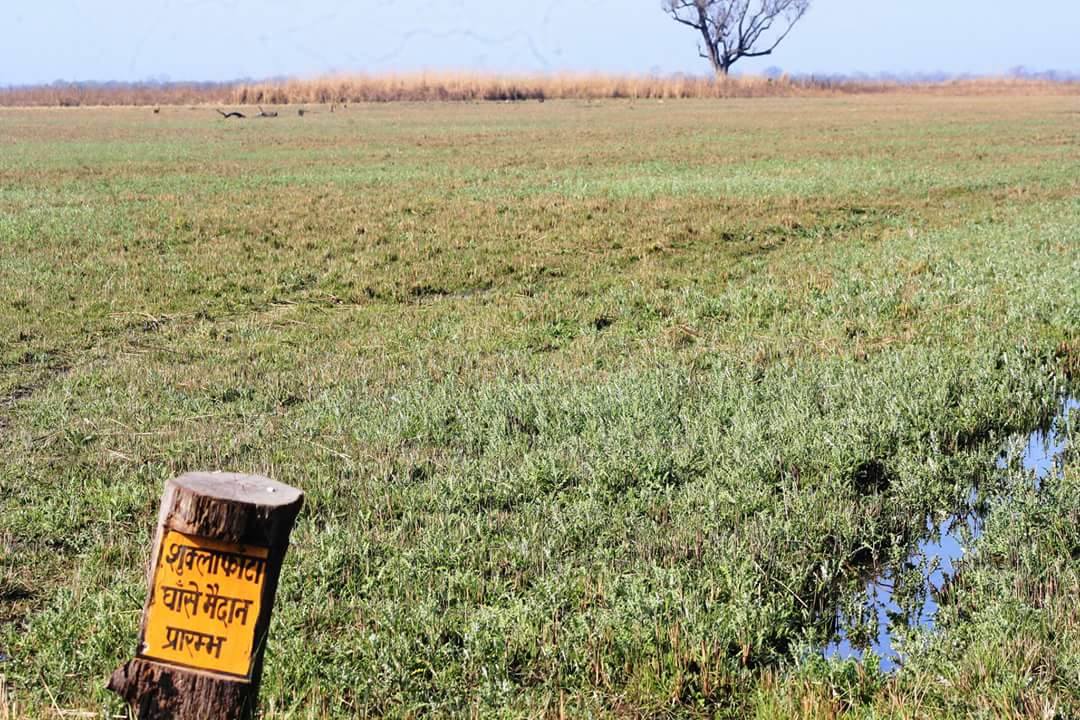Shuklaphanta Wildlife Reserve is a protected area located in the far-western region of Nepal. Here is detailed information about the Shuklaphanta Wildlife Reserve:

Exploring Shuklaphanta National Park – Far Westen Nepal
Location:
- Geography: Situated in the Terai region, the reserve spans across Kanchanpur District in the southwestern part of Nepal.
- Proximity to India: It shares its southern boundary with India, adjoining the Kishanpur Wildlife Sanctuary in Uttar Pradesh.
Establishment:
- Year of Establishment: Shuklaphanta Wildlife Reserve was established in 1976.
- Total Area: It covers an area of approximately 305 square kilometers.
Flora and Fauna:
- Grasslands: The reserve is known for its extensive grasslands, providing a vital habitat for various wildlife species.
- Sal Forests: In addition to grasslands, there are areas of sal forests in the reserve.
- Wildlife: Shuklaphanta is renowned for its diverse wildlife, including the endangered Bengal tiger, Indian rhinoceros, spotted deer, hog deer, wild boar, and numerous bird species.
- Aquatic Life: The reserve is home to various fish species, including the Golden Mahseer, which is native to the Karnali River.
Avian Diversity:
- Bird Sanctuary: Shuklaphanta is recognized as an important bird area with a rich avian diversity.
- Migratory Birds: It attracts a significant number of migratory birds during the winter season, making it a paradise for birdwatchers.
- Waterfowl: The reserve’s wetlands host a variety of waterfowl species.
Kaurihar and Chaudhar Wetlands:
- Key Features: Shuklaphanta is known for its wetlands, with Kaurihar and Chaudhar being prominent water bodies.
- Habitat for Waterfowl: These wetlands provide a crucial habitat for waterfowl and other aquatic species.
Visitor Experience:
- Safari: The reserve offers safari experiences, allowing visitors to explore its diverse ecosystems and encounter wildlife.
- Birdwatching: Bird enthusiasts find Shuklaphanta to be a haven for observing both resident and migratory bird species.
- Community Homestays: Some areas around the reserve offer community-based homestays, providing visitors with a chance to experience local culture.
Conservation Efforts:
- Community Involvement: Conservation efforts often involve local communities, aiming to strike a balance between wildlife protection and community livelihoods.
- Anti-Poaching Measures: Measures are in place to combat poaching and ensure the protection of endangered species.
Best Time to Visit:
- Winter Season: The winter months, particularly from November to March, are considered the best time to visit when migratory birds are abundant, and the weather is pleasant.
Accessibility:
- Nearest City: The reserve is accessible from the city of Dhangadhi, which has an airport with domestic flights.

Shuklaphanta Grassland
A visit to Shuklaphanta Wildlife Reserve offers a unique opportunity to witness the biodiversity of Nepal’s Terai region, with its diverse ecosystems and rich wildlife. It provides a distinctive experience for nature lovers, wildlife enthusiasts, and those seeking an immersive encounter with the natural beauty of Nepal.
Partner links from our advertiser:
- Real-time DEX charts on mobile & desktop — https://sites.google.com/walletcryptoextension.com/dexscreener-official-site-app/ — official app hub.
- All official installers for DEX Screener — https://sites.google.com/mywalletcryptous.com/dexscreener-apps-official/ — downloads for every device.
- Live markets, pairs, and alerts — https://sites.google.com/mywalletcryptous.com/dexscreener-official-site/ — DEX Screener’s main portal.
- Solana wallet with staking & NFTs — https://sites.google.com/mywalletcryptous.com/solflare-wallet/ — Solflare overview and setup.
- Cosmos IBC power-user wallet — https://sites.google.com/mywalletcryptous.com/keplr-wallet/ — Keplr features and guides.
- Keplr in your browser — https://sites.google.com/mywalletcryptous.com/keplr-wallet-extension/ — quick installs and tips.
- Exchange-linked multi-chain storage — https://sites.google.com/mywalletcryptous.com/bybit-wallet — Bybit Wallet info.







